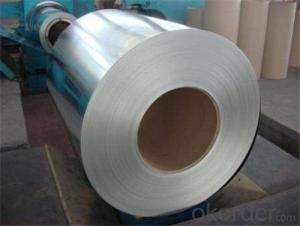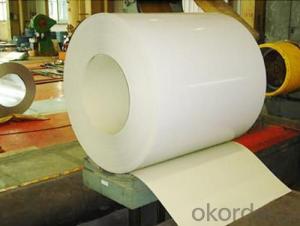1. Pre-Painted Galvanized/Aluzinc Steel Coil China Best
- Loading Port:
- China main port
- Payment Terms:
- TT OR LC
- Min Order Qty:
- 50 m.t.
- Supply Capability:
- 10000 m.t./month
OKorder Service Pledge
OKorder Financial Service
You Might Also Like
Specification
1. Pre-Painted Galvanized/Aluzinc Steel Coil China Best
With GI as base material, after pretreatment (degrease and chemical treatment ) and liquid dope with several layers of color, then after firing and cooling, finally the plate steel is called pre-painted galvanized (aluzinc) steel. Pre-painted galvanized steel is good capable of decoration, molding, corrosion resistance. It generally displays superior workability, durability and weather resistance.
2.Main Features of the Pre-Painted Galvanized/Aluzinc Steel Coil:
• Excellent heat resistance performance
• High strength
• Good formability
• Good visual effect
3.Pre-Painted Galvanized/Aluzinc Steel Coil Images


4.Pre-Painted Galvanized/Aluzinc Steel Coil Specification
Standard: AISI, ASTM, BS, DIN, GB, JIS
Grade: DX51D, DX52D
Thickness: 0.17-2.0mm
Brand Name: KMRLON
Thickness: 0.13-4.0mm
width: 20-1250mm
zinc coating: 40-180g/m2
printing thickness: top side: 20+/-5 microns, back side: 5-7 microns
coil ID: 508/610mm
5.FAQ of Pre-Painted Galvanized/Aluzinc Steel Coil
1. What’s the application of this product?
Roof, roof structure, surface sheet of balcony, frame of window, etc.
2. We have established the international advanced quality management system,every link from raw material to final product we have strict quality test;We resolutely put an end to unqualified products flowing into the market. At the same time, we will provide necessary follow-up service assurance.
3. How long can we receive the product after purchase?
Usually within thirty working days after receiving buyer’s advance payment or LC. We will arrange the factory manufacturing as soon as possible. The cargo readiness usually takes 15-25 days, but the shipment will depend on the vessel situation.
- Q: What are the common methods of cutting-to-length steel coils?
- Depending on the industry's specific requirements and capabilities, there are various common methods used to cut-to-length steel coils. 1. Shearing: For thinner gauge materials, one can utilize shearing, which involves using a shear blade to cut the steel coil into specific lengths. This cost-effective method is ideal for high-volume production. 2. Slitting: For narrower strips or multiple widths from a single coil, slitting is a suitable process. It entails passing the steel coil through rotating circular blades that cut the coil into desired widths. Slitting is commonly used for thinner gauge materials. 3. Laser cutting: To achieve precise and clean cuts, laser cutting employs a high-powered laser beam that melts and vaporizes the steel coil. This method is versatile, suitable for a wide range of materials, complex shapes, and contours. Laser cutting is often chosen for high-precision applications and smaller production runs. 4. Sawing: Thicker gauge materials are commonly cut using sawing. This method, which can be done manually or with automated sawing machines, involves using a saw blade to cut through the steel coil. Sawing is ideal for cutting large sections or heavy-duty applications. 5. Rotary cutting: Rotary cutting is frequently employed for thicker gauge materials in high-speed production. This method utilizes a rotary shear to cut the steel coil into desired lengths, providing a clean and accurate cut. Many industries prefer rotary cutting. It is important to consider that each method has its own advantages and limitations. The appropriate cutting method selection depends on factors such as material thickness, coil width, required precision, production volume, and budget constraints.
- Q: what happened to all the steel beams from the WTC buildings? did anyone do any forensic analysisof any of the steel?
- Some of the steel was recycled for sale to other countries where they aren't so picky about reusing building materials. NIST had 200 pieces of the steel for their investigation, which they returned last year. This was covered in the press. The rest of the steel was held at JFK international airport's Hangar 17. Much of it will be placed/has been placed in the new museum beneath the Memorial at the WTC site. Thousands of pieces are being given out for 9/11 memorials all over the world. Just about every day you read in the newspaper about another piece going here or there to this city or that city. Yes, a lot of the steel was tested for a number of chemical compounds. It had to be for safety reasons before storing it and giving it out. Depending upon what countries the recycled beams were sent to and their rules, it was sometimes tested at the ports of entry over there, as well.
- Q: How are steel coils used in the packaging industry?
- Steel coils are used in the packaging industry primarily for the production of metal strapping and seals. These coils are unwound and processed to create strong and durable strapping materials that are used to secure and bundle various types of packaging, such as boxes, crates, and pallets. The steel coils provide excellent tensile strength and resistance to breakage, making them ideal for ensuring the safe transportation and storage of goods.
- Q: Is steel with a black coloring as strong as regular steel. if you are asking why i have two wordsBlack Katana.I know a katana is not made with normal steel, it is made of two types with varying grades of carbon to give it speacial properties, i just want to know if the black will make a difference.
- There are many types of steel some very rigid, while you can have steel that is very flexible. The type of katana: steel is for Samurai swords
- Q: How are steel coils inspected for color consistency using colorimetry?
- Colorimetry is a method used to inspect steel coils for color consistency. This involves quantifying and measuring colors using specialized instruments like spectrophotometers or colorimeters. These instruments measure the hue, saturation, and brightness of the steel coil's color. A colorimeter is typically used to inspect steel coils for color consistency. This device emits light onto the surface of the coil and measures the amount of light reflected back. The reflected light is then analyzed and compared to a known standard color to identify any deviations. To measure color, the colorimeter breaks down the reflected light into different wavelengths and quantifies the intensity of each wavelength. This data is then converted into numerical values that represent the color of the steel coil. These numerical values can be compared to a predefined color standard to determine if the coil's color falls within an acceptable range. To ensure accurate and consistent color measurement, colorimetry relies on standardized color spaces like CIE L*a*b* or CIE RGB. These color spaces define specific ranges of colors. By using these standardized color spaces, colorimeters can provide objective and reliable measurements of color consistency. Color consistency is particularly important for industries like automotive or appliance manufacturing, where the appearance of the final product is crucial. By inspecting the color of steel coils using colorimetry, manufacturers can ensure that the final products have a consistent and visually appealing appearance. In conclusion, colorimetry is an effective method for inspecting steel coils for color consistency. By using specialized instruments and standardized color spaces, manufacturers can accurately measure and compare the color of steel coils to predefined standards, ensuring that the final products meet the desired color specifications.
- Q: How are steel coils used in the production of railway tracks?
- Steel coils are used in the production of railway tracks as they provide the raw material for manufacturing the rails. The steel coils are first processed and shaped into long, straight rails through various processes such as rolling and heat treatment. These rails are then laid and joined together to form the railway tracks, providing a sturdy and durable foundation for trains to run on.
- Q: Steel Strings on your guitar or nylons? Why?
- Kind of a silly question. I use steel strings on my steel string guitars and nylon strings on my classical guitar. It's not something you have any choice in; steel string guitars must use steel strings and classical guitar must use nylon strings.
- Q: What are the different surface treatments for steel coils?
- There are several different surface treatments available for steel coils, depending on the desired outcome and application. Some of the most common surface treatments for steel coils include: 1. Hot-dip galvanizing: This process involves immersing the steel coils in a bath of molten zinc, which forms a protective layer on the surface of the steel. Hot-dip galvanizing provides excellent corrosion resistance and is often used for outdoor applications. 2. Electro-galvanizing: Similar to hot-dip galvanizing, but instead of immersing the steel coils in molten zinc, a thin layer of zinc is electroplated onto the surface of the steel. Electro-galvanizing provides good corrosion resistance and is commonly used for indoor applications. 3. Powder coating: This process involves applying a dry powder to the surface of the steel coils, which is then heated and cured to form a hard, durable coating. Powder coating provides excellent corrosion resistance and is available in a wide range of colors and finishes. 4. Paint coating: Steel coils can also be coated with a liquid paint, which provides both corrosion resistance and aesthetic appeal. Paint coatings can be applied in various thicknesses and finishes, depending on the desired look and level of protection required. 5. Phosphating: Phosphating is a chemical treatment that involves immersing the steel coils in a phosphate solution. This process creates a thin, adherent layer of phosphate on the surface of the steel, which enhances paint adhesion and improves corrosion resistance. 6. Chromate conversion coating: Also known as chromating or passivation, this process involves immersing the steel coils in a solution containing chromium salts. Chromate conversion coatings provide excellent corrosion resistance and also act as a primer for subsequent paint or powder coating. 7. Zinc-nickel plating: This surface treatment involves electroplating a layer of zinc-nickel alloy onto the steel coils. Zinc-nickel plating provides superior corrosion resistance compared to pure zinc plating and is often used in demanding environments. These are just a few of the many surface treatments available for steel coils. The choice of treatment depends on factors such as the application, desired level of corrosion resistance, aesthetic requirements, and budget. It is important to carefully consider the specific needs of the project and consult with experts to determine the most suitable surface treatment for steel coils.
- Q: How are steel coils inspected for surface finish using profilometry?
- Steel coils are inspected for surface finish using profilometry by measuring the surface topography using a profilometer. The profilometer scans the surface of the steel coil and records the deviations from the ideal surface. This data is then used to determine the roughness, waviness, and other surface parameters of the steel coil, providing a quantitative assessment of its surface finish quality.
- Q: Can i make holes in iron and steel with somekind of drill bit. All i have is metal drill bits. Mabey like 68 of them but i dont know wich one to use and if they will penetrate.
- Drills are used to make holes in steel all the time.
Send your message to us
1. Pre-Painted Galvanized/Aluzinc Steel Coil China Best
- Loading Port:
- China main port
- Payment Terms:
- TT OR LC
- Min Order Qty:
- 50 m.t.
- Supply Capability:
- 10000 m.t./month
OKorder Service Pledge
OKorder Financial Service
Similar products
Hot products
Hot Searches
Related keywords






























